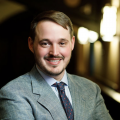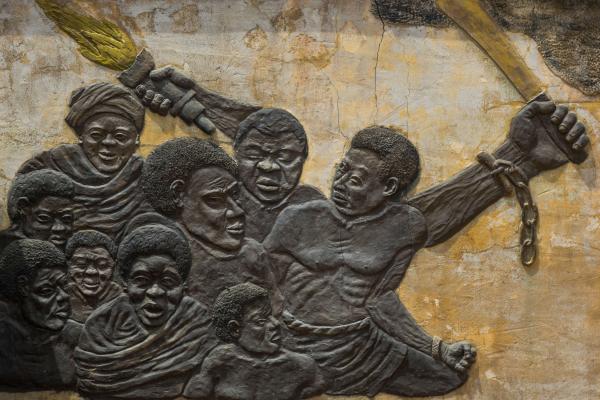I am the senior minister of Lake Street Church of Evanston, Ill., a predominantly white church striving to address its legacy of white supremacy and move into the future. Lake Street sits at a prominent intersection where you can see the spire that was once the tallest point in town. It’s the sort of church that people drop by to see the beautiful interior. In 1882 it also became the site of a racial wound: Ten Black members led by Nathan Branch asked for their letters of dismissal from our church to form Second Baptist Church in Evanston. One of the reasons for this decision was to create strong, independent Black institutions. The other reason for this split was because white supremacist congregants called African American members like Branch “brother,” while forcing them to sit in segregated seating. Second Baptist remains a predominantly African American congregation and it’s now one of the most active churches in Evanston.
Everyone in my congregation knows this story because it laid the current foundations for our church. Acknowledging this wound has been an important part of our journey and we have formed a strong relationship with our sister church, Second Baptist. That relationship has been transformative as it has become clear over the past few years that the wound is the start of our journey together, rather than an end. As our city pilots one of the first reparations programs in the country, we have been wrestling with what restoration and healing mean for our church specifically. Now, we are moving toward becoming co-owners of our building with Second Baptist.
Rev. Michael Nabors, the pastor of Second Baptist and a major advocate for Evanston’s reparations initiative, has made the case that Evanston’s reparations initiative can be successful because it’s a small city where people have substantive relationships. What if we also thought about churches as spaces where reparations are uniquely possible? Since churches are institutions rooted in a particular place, memories of harm and past wrongdoing tend to linger and reverberate; but with this deep woundedness comes the potential for accountability. After all, so many churches in communities across this country are the result of splits over race: These churches cover our nation like open sores, yearning to be healed.
One prominent example of this wound is the Southern Baptist Convention’s recent fight over critical race theory. As a result, many Black Southern Baptists have felt silenced and prominent Black pastors like Charlie Dates and Ralph D. West have publicly split with the denomination for its stance on critical race theory. On a more local level, many churches in communities across the United States have intertwined, painful histories based on race.
Both in our personal lives and within the broader community of Evanston, becoming familiar with this painful history has caused questions of healing and transformation to take center stage. As Lake Street has been wrestling with what reconciliation and reparations look like, the words of the prophets have loomed large. In both Jeremiah and Ezekiel, there is an extended reflection on wounds and what it takes to heal them. “They have treated the wound of my people carelessly, saying, ‘Peace, peace,’ when there is no peace” (Jeremiah 6:14, with versions appearing in Jeremiah 8:11, Ezekiel 13:10 and 13:16). For churches wrestling with white supremacy, the temptation to rush toward pronouncing “peace, peace” is ever-present. Preemptively proclaiming peace is easy, but it is difficult to embrace accountability and treat wounds.
Evanston is beginning to treat some of its wounds. Sixteen residents just received the first $25,000 reparations payments for housing discrimination and redlining that the city of Evanston participated in from 1919 - 1969. Our congregation has been learning about reparations for over a year and recently passed a resolution at our church's annual meeting in support of the city's reparations initiative and reparations more generally. But merely passing resolutions or learning about racism is not the same thing as practicing reparations. Churches must follow words with action (James 2:14-29).
Taking action means that white congregations must decenter themselves. In naming our desire to practice reparations with Second Baptist, we have been careful not to foreclose what those reparations might look like as we continue to dream together in discernment. Whatever actions we take, Second Baptist will lead the way.
With Second Baptist in the lead, we are asking together, “As the original location where racist actions took place, can this building also be a place where wounds are treated?” For 140 years, Lake Street has claimed exclusive use of a space that is not exclusively ours. Restoring Second Baptist’s ownership of the building is a tangible step toward healing racial wounds, but it is not the last step. It is our hope that it will inspire deeper partnership, accountability, and the capacity for even greater healing.
But healing wounds requires that we move past words. It’s not that words are unimportant. We need churches to hang Black Lives Matter flags, read Indigenous land acknowledgments, and speak out publicly in support of justice. But those words or rituals are insufficient on their own. We cannot risk treating these racial wounds lightly, crying “peace, peace,” when there is no peace.
In effect, imagining churches as places uniquely positioned for practicing reparations means a paradigm shift in how churches imagine themselves in their communities. Churches are capable of celebrating beauty but they are also capable of creating wounds. Such a shift would be akin to what theologian Rev. Kelly Brown Douglas refers to as “broaden[ing] our moral imagination.” For the church to broaden its moral imagination, congregations need to start asking questions like: What does it mean to own property? Who did that exclude in the context of redlining? What assumptions are we making about the assumed good of a church’s continued existence in a place? Being open to accountability and discernment about reparations means that no question, no matter how difficult or threatening to the continuance of a congregation, is off-limits.
The healing of wounds requires actions; action must cost something. In The Cost of Discipleship, German theologian and Christian martyr Dietrich Bonhoeffer contrasts “cheap grace” with “costly grace.” Whereas cheap grace consists of “the preaching of forgiveness without requiring repentance,” costly grace “is the treasure hidden in the field; for the sake of it a man will gladly go and sell all that he has.” Applying this insight in the context of conversations around reparations, white churches must value reparations more than their property, power, or prestige. The true treasure hidden in churches like ours is the possibility of practicing reparations.
Many churches that are interested in addressing white supremacy fail to see the resources at their disposal. They also fail to see how their building might be a source of wounding in their community. Will they put their resources on the line in order to heal those wounds? Will they pursue the costly grace that Bonhoeffer names? At my church, that answer is starting to become “yes,” as we consider reconciliation and reparations as more important than our own existence or property ownership. I would liken this process to a conversion experience insofar as it has opened our eyes to creative ways of thinking about healing our own wounds as well as the wounds of others.
As my church has been deepening its relationship and commitment to addressing its foundation in white supremacy, we have been wrestling more deeply with the question of what reparations and reconciliation look like. For us, that means more than simply hanging up Black Lives Matter signs or saying the right things about diversity. It means questioning the very foundations of our existence and laying claim to a grace that is costly.
Editor's note: This piece was updated on Feb. 25, 2022 at 3 p.m. to clarify the scope of Lake Street Church's reparations resolution.
Got something to say about what you're reading? We value your feedback!







